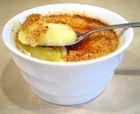|
French Dessert Cream Custard A creamy custard dish with a delicious carmelized sugar crust. Ooooh, it is so good!
Heat cream in a double boiler, stirring constantly till a thin skin appears on the top. Set aside to cool for a few minutes. Beat eggs in a medium-sized mixing bowl. In a separate bowl, combine sugar and cornstarch; slowly add this mixture to beaten eggs, whisking vigorously. Then, in a thin stream, slowly add hot cream to eggs, whisking all the while (careful not to cook eggs). Return custard to double boiler and continue stirring, 5-7 minutes till the custard thickens and coats a metal spoon. Do not allow it to come to a boil! Remove from heat and add vanilla extract and lemon zest. Pour custard into 6 individual ramekins or a single 1-qt. soufflé dish. Chill for 3 hours till firm. Sprinkle tops with brown sugar. Hold a kitchen or chef’s torch over the tops of the custard for a few seconds, till sugar bubbles and turns into a crispy golden glaze.* Chill again and serve cold. * You can also put the custard under the broiler for a minute or so. But place ramekins in a pan of ice, first, then place the pan underneath the broiler—otherwise, the severe change in temperature could crack the ramekins. |
Tips & Glossary Bouquet Garni: (boo-kay gar-nee) bundle of herbs tied together with string or wrapped in cheese cloth square; usually parsley, thyme, bay leaf, and peppercorns. Flavor is released during long cooking.Remove before serving. Chervil: (sher-vil) related to parsley but has a delicate anise flavor. Long cooking kills flavor, so add at the last minute. Cornichon (kor-nee-shon) teeny-tiny pickle, served with pates & smoked meats; found in specialty food stores. Fines Herbes: (feen-airb) mix of finely chopped herbs: parsley, chives, tarragon, & chervil. Not as strong as a bouqet garni. Buy it at most grocery stores. Fromage: (fra-mahj) Cheese! The French eat more than any nationality, 45 pounds per capita per year; and the country makes more cheeses than any other country, about 400. Herbes de Provence (airb-duh-pro-vonce): mix of dried herbs, usually thyme, rosemary, marjoram, basil, & bay leaf Can be found at most grocery stores. Mutarde: (moo-tard), mustard. Most famous: Nicoise Olive: (nee-swaz- oh-leev) small, purplish-black olive with a mellow, nutty flavor; used primarily in Salade Nicoise. The Picholine variety is a green, medium-sized olive with a light, nutty flavor. Roux: (roo) paste-like mix of melted butter and flour, into which liquid is gradually added. The basis of every classic French sauce.
|
Site by BOOM
![]()
LitLovers © 2024

